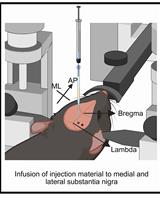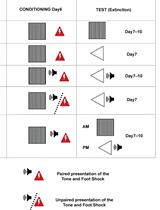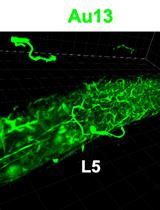- EN - English
- CN - 中文
Transplantation of Embryonic Cortical Tissue into Lesioned Adult Brain in Mice
将胚胎皮质组织移植到病变的成年小鼠脑中
发布: 2017年06月20日第7卷第12期 DOI: 10.21769/BioProtoc.2360 浏览次数: 8651
评审: Xi FengEdel HennessyJingang Huang

相关实验方案

基于 rAAV-α-Syn 与 α-Syn 预成纤维共同构建的帕金森病一体化小鼠模型
Santhosh Kumar Subramanya [...] Poonam Thakur
2025年12月05日 1395 阅读
Abstract
Transplantation of embryonic cortical tissue for repairing the damaged brain has provided a potential therapy for brain injury and diseases. The grafted tissue can successfully survive and participate in reestablishing the functional neural circuit of the host brain. Transplantation surgery can be combined with fluorescently labeled transgenic mice to evaluate the reconstruction of neuronal network (Falkner et al., 2016) and the repopulation of a subset of cortical cells. By using this approach, we have shown that infiltrating cells from host brain can restore the microglial population in the graft tissue (Wang et al., 2016). This protocol describes the detailed procedure of the transplantation surgery in mice, including establishing a lesion model in the host brain, preparing the embryonic cortical graft, and transplanting the embryonic cortical graft to adult brain.
Keywords: Transplantation (移植)Background
Most neurons in adult brain are post mitotic cells and are not capable of regenerating new daughter cells, this results in a limited ability of self-repairing of adult brain after suffering from brain injury or diseases. Replacing the damaged brain tissue with embryonic neural graft is one of the potential effective therapies to repair the damaged neural pathways in the adult brain (Tuszynski, 2007). Much attention has been drawn to this field of study since the 1970s (Das and Altman, 1972; Bjorklund and Stenevi, 1979) and remarkable successes have been achieved during the last three decades. These studies have shown that neurons in grafted tissue can successfully survive in host brain and develop efferent projections to reestablish synaptic connections between the host and donor neurons (Gaillard and Roger, 2000; Gaillard et al., 2004; Gaillard, 2007; Gaillard et al., 2007; Falkner et al., 2016). Electrophysiological evidence suggests that the grafted neurons develop functional connections in the host cortices of adult animals (Gaillard and Domballe, 2008; Santos-Torres et al., 2009; Jimenez-Diaz et al., 2011) and the data of behavioral tests indicate that the damaged functions can be partially restored after transplantation (Plumet et al., 1993; Riolobos et al., 2001; Gaillard et al., 2007). Our recent study suggests that there is an interactive relationship between the host brain and the transplanted tissue. The transplanted tissue provides neurons to repair the damaged circuit, and host brain can restore the microglial population in the grafted tissue (Wang et al., 2016). However, the survival and differentiation of other essential cell subsets (such as astrocyte and oligodendrocyte) and their roles and functions in the grafted tissue remain undetermined. We hope the approach we described here can be combined with other cutting-edge techniques to reveal the mechanism underlying the reconstructing process between the host brain and transplanted tissue.
Materials and Reagents
- Double-edge razor blade (SHANGHAI RAZOR BLADE, catalog number: 74-s , or Gillette, catalog number: PLATINUM-PLUS® )
- Microsurgical blade (Salvin Dental Specialties, catalog number: 6900 )
- Superglue (cyanoacrylate, Products of ALTECO CHEMICAL, catalog number: SG-12 )
- Gelfoam (Zhejiang AOKI Medical Dressing or Pfizer, catalog number: AZL0009034201 )
- 24-well cell culture plate (Corning, NY)
- 90 mm culture dish (Guangzhou Jet Bio-Filtration, catalog number: TCD010090 )
- Filter paper (Autoclaved)
- Toothpick (Autoclaved)
- Surgical sutures (Yangzhou Jinhuan Medical Apparatus Factory, material: silk, size: 5-0 UPS standard)
- 1 ml Insulin syringe (Shandong Weigao Group Medical Polymer, catalog number: B-D328404Z or BD, catalog number: 328404 )
- 5 ml plastic transfer pipette (Sterilized)
- Mice
Note: Mice of both sexes at the age of 3-4 months are highly recommended to be used as host mice (recipient) in this protocol, and the fetus at the Embryonic day 14 (E14) or E15 (both genders) is used as donor, the strain of mice is depended on the purpose of study. - 75% ethanol (Tianjin Fuyu Fine Chemical)
- Erythromycin ointment (paraffin based lubricant is also recommended)
- Iodine tincture
- Ketamine (Fujian Gutian Parma, catalog number: H35020148 )
- Xylazine (Sigma-Aldrich, catalog number: X1251-1G )
- Sodium chloride (NaCl) (Beichen fangzheng, Tianjin; or Sigma-Aldrich, catalog number: S5886 )
- Potassium chloride (KCl) (Haiguang, Tianjin; or Sigma-Aldrich, catalog number: P5405 )
- Potassium phosphate monobasic (KH2PO4) (The sixth chemical plant, Tianjin; or Sigma-Aldrich, catalog number: P5655 )
- Sodium phosphate dibasic (Na2HPO4) (Sigma-Aldrich, catalog number: S9763 )
- Calcium chloride (CaCl2·2H2O) (Sigma-Aldrich, catalog number: C7902 )
- Magnesium sulfate (MgSO4·7H2O) (Sigma-Aldrich, catalog number: 63138 )
- Na+-HEPES (Sigma-Aldrich, catalog number: H7006 )
- Sodium bicarbonate (NaHCO3) (Sigma-Aldrich, catalog number: S5767 )
Note: This product has been discontinued. - Glucose
- Urethane (Sigma-Aldrich, catalog number: 94300 )
- Ketamine-Xylazine mixture (KX) (see Recipes)
- Phosphate buffered saline (PBS) (see Recipes)
- Hanks balanced salt solution (HBSS) (see Recipes)
- Urethane solution (see Recipes)
Equipment
- Dental drill (SEASHIN PRECISION, catalog number: STRONG 90 )
- Curved scissors, cutting edge: 14 mm, material: stainless steel (Fine Science Tools, catalog number: 14084-09 )
- Heating pad (Tme, model: JR-1/2 DC )
- Dissecting microscope (Olympus, model: SZ61 )
- Straight scissors, cutting edge: 14 mm, material: stainless steel (Fine Science Tools, catalog number: 14085-09 )
- Thin-tipped forceps (Fine Science Tools, model: Dumont #5 )
- Straight forceps (VETUS, catalog number: ST-14 )
- Curved forceps (Fine Science Tools, model: Dumont #5/45 )
- Custom-made steel plate (see Figure 1B)
- Compressed air (Sunto, catalog number: ST1005 )
- Biosafety cabinet (Jiangsu Sujing Group, model: BCM-1300A )
- Refrigerator
Software
- ImageJ software (http://rsb.info.nih.gov/ij)
Procedure
文章信息
版权信息
© 2017 The Authors; exclusive licensee Bio-protocol LLC.
如何引用
Wang, C., Gao, H. and Zhang, S. (2017). Transplantation of Embryonic Cortical Tissue into Lesioned Adult Brain in Mice. Bio-protocol 7(12): e2360. DOI: 10.21769/BioProtoc.2360.
分类
神经科学 > 神经系统疾病 > 动物模型
干细胞 > 胚胎干细胞 > 细胞移植
您对这篇实验方法有问题吗?
在此处发布您的问题,我们将邀请本文作者来回答。同时,我们会将您的问题发布到Bio-protocol Exchange,以便寻求社区成员的帮助。
Share
Bluesky
X
Copy link










